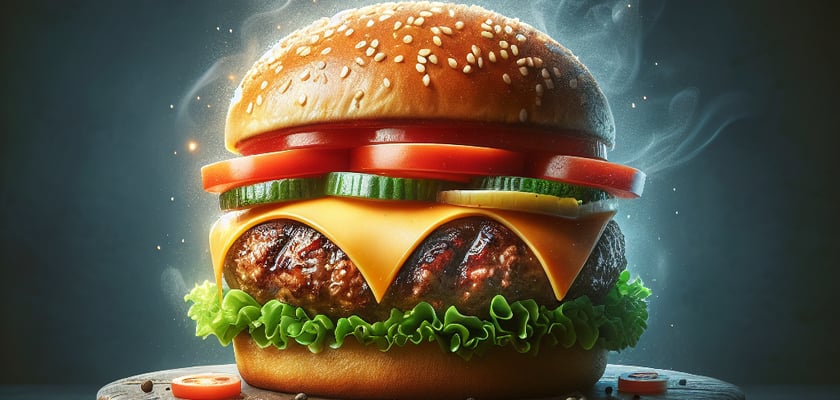Ah, the cheeseburger—a culinary high-five, a symphony of sizzle and cheese, the heavyweight champion in the fast-food arena. It’s not just a patty sandwiched between buns; it’s an edible embodiment of Americana, dripping with melty cheesy goodness and a lineage that could trace back to German immigrants or a random stroke of American genius. That’s right, its history is as melted and mixed as the cheddar on top. The cheeseburger doesn’t just tantalize our tastebuds; it’s a social leveller, a meal that billionaire tech moguls and hungry college students can equally indulge in with gleeful abandon. It’s the romantic comedy of meals—familiar, comforting, and loved by everyone, even if they don’t admit it.
Now that your mouth is watering like a garden sprinkler and your stomach is rumbling louder than thunder on a stormy night, I’ll let you in on a little secret. The next part of this rollercoaster ride through Cheeseburgerland is packed with juicy tidbits and sizzling secrets that’ll turn your kitchen into the next hip burger joint. We’re not just throwing frozen patties on the grill and slapping on a slice of government cheese; oh no, we’re talking gourmet-level craftsmanship that’ll have your taste receptors doing the electric slide. So strap in, prep your napkins, and get ready for the next segment where we’ll be serving up some serious key takeaways to craft your very own lip-smacking, crowd-cheering, taste-bud-tantalizing cheeseburger. Stay hungry, because the good stuff is just a flip of the patty away.
Key points I covered in this post
1. Select high-quality meat with an optimal fat content of approximately 20% for the right balance of juiciness and flavor. Ground chuck is often recommended for its rich taste and ideal fat ratio.
2. Season the burger patties generously with salt and pepper just before cooking to ensure they are flavorful throughout. Avoid overworking the meat to maintain a tender texture in the finished burger.
3. Preheat the grill or pan to a high temperature before cooking the patties to achieve a seared crust which locks in juices. Cook to the desired level of doneness, typically three to four minutes per side for medium-rare.
4. Choose a cheese that melts well, such as cheddar, Swiss, or American, and add it to the burger shortly before removing from the heat to allow it to melt properly. This contributes to the overall richness and gooey texture of the cheeseburger.
5. Toast the burger buns on the grill or in a pan to add a subtle crunch and prevent them from becoming soggy when the burger and its toppings are assembled. The buns can be lightly buttered for an extra hint of flavor.
**What Does It Take to Make a Delicious Cheeseburger?** Crafting a mouthwatering cheeseburger entails selecting premium, fresh ingredients starting with high-quality ground beef, preferably an 80/20 blend of lean to fat ratio for optimum juiciness. Choose an artisanal cheese that melts well, like sharp cheddar or creamy gouda. Compliment with fresh, crisp lettuce, ripe tomatoes, and thinly sliced red onions on a toasted, buttery brioche bun. Attention to detail is key — season the patty generously with salt and pepper before cooking to perfection on a hot grill or skillet and assemble swiftly to savor the warmth and textures.
Choosing the Right Beef
Starting with the right beef is crucial for a delicious cheeseburger. Opt for fresh, high-quality ground beef with an 80/20 mix of lean meat to fat. This ratio ensures a juicy and flavorful patty once cooked. Season the meat with salt and pepper, and form patties that are about ½ inch larger than the diameter of your buns, as they will shrink during cooking. Make a small indent in the center of each patty to prevent them from doming up as they cook.
Perfecting the Patty
When it comes to cooking the patties, there are a couple of methods including grilling outdoors or pan-frying indoors. For grilling, preheat to a high temperature and cook the patties for about 3 to 4 minutes per side for a medium-rare finish. If pan-frying, use a cast-iron skillet for a beautiful sear and cook similarly, pressing down slightly on the patty to ensure even contact with the hot surface. Both methods should be done over high heat to achieve a crispy, caramelized crust without overcooking the inside.
Cheese Matters
The choice of cheese can add a unique flavor profile to your cheeseburger. Aim for a cheese that melts well and complements the beef. Classic options include American, cheddar, pepper jack, or Swiss. Add the cheese to the patty during the last minute of cooking to ensure a perfect melt. Covering the pan or closing the grill will trap heat and help the cheese to melt evenly over the patty.
The Role of the Bun
Do not underestimate the importance of a great bun. A freshly baked brioche bun is ideal for its light texture and slightly sweet flavor. Before assembling your burger, toast the bun on the grill or in a pan to add a bit of crunch and prevent it from getting soggy. This will also contribute an extra layer of a rich, buttery flavor that can elevate the overall taste experience.
Toppings and Condiments
Toppings are an area where you can tailor your cheeseburger to personal tastes. Traditional toppings include crisp lettuce, fresh tomato slices, and red onion rings, but feel free to be creative. You can add pickles for tang, avocado slices for creaminess, or even a fried egg for richness. The choice of condiments can range from the classic ketchup and mustard to aiolis, specialty sauces, or relishes that deliver a punch of flavor with each bite.
Assembly Is Key
Proper assembly of your cheeseburger can make a significant difference in flavor distribution and texture. Begin with the bottom bun, followed by condiments of choice, the lettuce which acts as a barrier to prevent sogginess, then the tomato, patty with melted cheese, any additional toppings like onions or pickles, and more condiments on the top bun if desired. Making sure to layer in this order helps to keep the structural integrity of the cheeseburger and ensures that every bite is as delicious as possible.
Finishing Touches
A cheeseburger isn’t quite complete without a few final touches. This can include a light sprinkle of flaky sea salt on the tomato, a crack of fresh black pepper over the assembled burger, or even a drizzle of a high-quality olive oil for a touch of richness. By paying attention to these small details, you can truly elevate the homemade cheeseburger from good to great. Serve immediately after assembly for the best taste experience.
What Are Some Essential Cheeseburger-Making Tips?
- Always use high-heat for cooking the patties to get a nice sear on the outside while keeping the inside juicy.
- Do not press down on the patties too much during cooking, as this squeezes out the flavorful juices.
- Let the cooked patties rest for a couple of minutes after cooking before assembly to allow the juices to redistribute.
- Lightly butter the buns before toasting for an extra layer of flavor and a texture that complements the juicy patty.
- Experiment with different cheeses and toppings to find the perfect combination that suits your taste buds.
What type of cheese works best for a delicious cheeseburger?
The type of cheese you choose for your cheeseburger can significantly impact its flavor and texture. Classic options include American cheese for its excellent melting qualities and mild taste, cheddar for a sharper kick, and Swiss for a nutty flavor. However, feel free to experiment with other types like gouda, pepper jack, or blue cheese to find your personal favorite.
How do you know when the burger is perfectly cooked?
The perfect level of doneness for a burger is largely a matter of personal preference, ranging from rare to well-done. However, the USDA recommends cooking ground beef to an internal temperature of 160°F to ensure safety. Use a meat thermometer to check the temperature, and look for a firm but juicy patty that’s brown throughout for a well-cooked burger.
Should you season the meat before or after forming the patties?
It’s best to season the ground beef after forming your patties. This way, you can create an even crust of seasoning that will boost the flavor of the meat without overworking it, which can make your burgers tough. Just remember to season generously on the outside right before grilling or cooking.
Is there a secret to keeping the burgers moist?
To keep your burgers moist, avoid pressing down on them while they’re cooking, as this can squeeze out the flavorful juices. Also, using a blend of meats with a good fat content, like 80/20 ground beef, will help ensure your burgers are juicy. Be careful not to overcook, as this is the most common cause of dried-out burgers.
What is the best method for cooking a cheeseburger?
There is no one-size-fits-all answer as the best method can depend on preference and situation. Grilling is a popular option that imparts a smoky flavor, while cooking in a cast-iron skillet creates a crispy, caramelized crust known as the Maillard reaction. Both methods can produce delicious results when performed correctly. Consider the flavor and texture you’re aiming for and choose accordingly.
Final Thoughts
Creating the perfect cheeseburger is both an art and a science. From choosing the right cheese to mastering the cooking technique, each element plays a pivotal role in the final taste and quality of your burger. Remember to handle your patties gently, season them well, and cook them to your preferred level of doneness for the best gourmet experience right at home. Most importantly, don’t be afraid to experiment and play with flavors—finding your ultimate cheeseburger recipe is a delicious journey worth taking.
At the end of the day, making a delicious cheeseburger is about combining quality ingredients with tried-and-true cooking techniques. Whether you’re a seasoned grill master or a novice cook, every cheeseburger you make is an opportunity to refine your skills and explore new flavors. So fire up your grill or stovetop, gather your favorite toppings and buns, and get ready to craft the ultimate cheeseburger that will be a hit at any gathering or a special treat for yourself.

